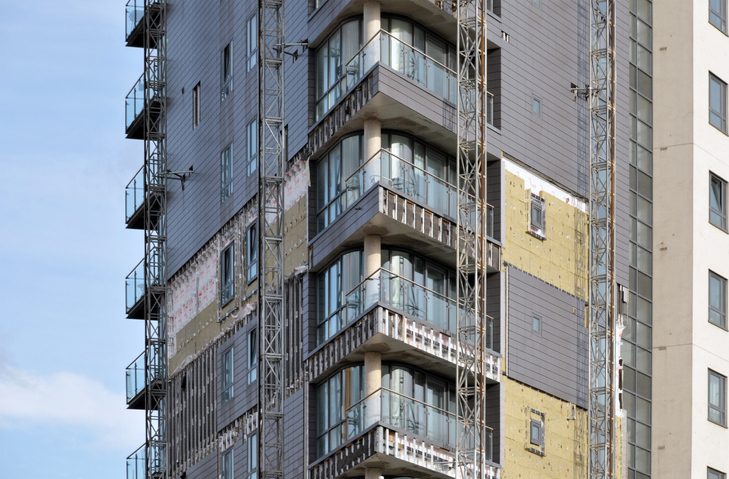Landmark ruling on cladding
First decision following the Grenfell Tower fire in 2017, awarding damages for the replacement of the cladding system.
Following the Grenfell Tower fire in 2017, the Technology and Construction Court has reached its first decision after a full trial relating to building safety with Martlet Homes Ltd v Mulalley & Co Ltd [2022] EWHC 1813 (TCC), in what is being described as a landmark ruling.
In the judgment the defendant, Mulalley & Co Limited (Mulalley), was ordered to pay damages towards the cost of removing cladding it had fitted to four residential tower blocks in Gosport, Hampshire which had been deemed to be unsafe. It is the first time that financial liability for remediation work on unsafe cladding has been established in court.
Martlet Homes Limited (Martlet) is part of the Hyde Housing Group, one of the largest housing associations in England, owning or managing around 50,000 homes in London, Kent, Surrey, Sussex, Hampshire, the East of England and East Midlands.
The Case
Martlet is the owner of five tower blocks in Gosport and sought to recover around £8 million in damages from the building contractor, Mulalley, to remedy external wall insulation (EWI) rendered cladding that was originally fitted by Mulalley between 2005 and 2008 under a design and build contract, and to provide a “waking watch” as a fire safety precaution until the cladding had been removed. A waking watch is a fire safety system where trained persons patrol the floors and the exterior perimeter of a building to provide a visible safety presence, check for fires or fire risks and defects and ensure sufficient warning in the event of a fire. The cause and justification for the replacement works and the waking watch was Martlet’s realisation of the risks posed following the Grenfell Tower fire in 2017.
The original building contract for the refurbishment of the buildings in 2005 was based on the JCT 1998 Standard Form of Building Contract with Contractor’s Design with some amendments. No particular problem was experienced with the cladding system following its completion.
Following the Grenfell Tower fire, Martlet immediately investigated its own high-rise residential tower blocks, revealing that the cladding system included combustible Expanded Polystyrene (EPS) insulation boards as well as some serious installation defects, such as defects in the installation of the fire barriers. On the day of the first inspection Martlet implemented a waking watch, which stayed in place until the removal of the insulation boards. Also, after further investigation, Martlet decided to replace the entire EWI cladding with a non-combustible cladding system.
The decision
A crucial element of the case was the limitation on Martlet’s ability to recover, namely whether the cost of replacing the cladding (as opposed to its repair) as well as the cost of maintaining a waking watch should be awarded. This depended on whether the judge found that there was either only an installation breach or whether a specification breach could be confirmed.
If there was only an installation breach, the damages awarded would be limited to the cost of the alternative repair scheme put forward by Mulalley. However, if there was a specification breach, the cost of the replacement scheme as well as the waking watch would be recoverable.
The Judge stated that Martlet would have succeeded on the recovery of the waking watch even if they would have only succeeded on the installation breach rather than the specification breach.
- Installation breaches
The architectural experts agreed in a joint statement that there were certain defects in the installation of the fire barriers, such as vertical gaps between sections and steel fixings being too short, that meant that the works did not comply with the Building Regulations as well as other guidance. This accorded with the initial inspection in 2017. The Judge was therefore satisfied that there were installation breaches in relation to the fire barriers.
- Specification breaches
This had to be assessed on a hypothetical basis (i.e. as if the system had been installed without the installation breaches) to decide whether replacement of the system would have been justified in absence of the installation breaches. The Judge found that Mulalley was in breach of their contractual duty of care in relation to the design/specification of the works as they failed to follow recommendations and advice set out in BRE 135(2003) (fire performance on external thermal insulation for walls of multistorey buildings) and that the system had failed to satisfy those functional requirements.
The Judge did not think there had been a breach of warranty that the system would be suitable for tall constructions as the parties relied on general statements which the judge stated did not amount to a specific warranty to that effect. .
The judgment is not only a good indication on the likelihood of similar future claims success and the amount recoverable, but also an important decision to take into account when negotiating new contracts. It was a significant victory for the claimant and it provides a promising outlook for other UK building owners facing similar cladding issues, giving much needed guidance on the court’s approach to the issues affecting numerous ongoing cladding disputes.
Involved in the case as an expert witness for the claimant, and mentioned throughout the judgment, was James Lavender, a director and a Chartered Engineer, registered with the Institution of Fire Engineers, at Trigon Fire Safety Limited. Speaking about his involvement, James said “It was a privilege to be instructed on such a ‘landmark’ matter. The case investigated, in great detail, the specification, design and installation of the external wall system as well as the intent of various design guidance documents, emphasising the importance of understanding the details of both aspects.”
If you have any questions or would like assistance with a design and build contract, you can contact our Commercial and Technology team at [email protected].

